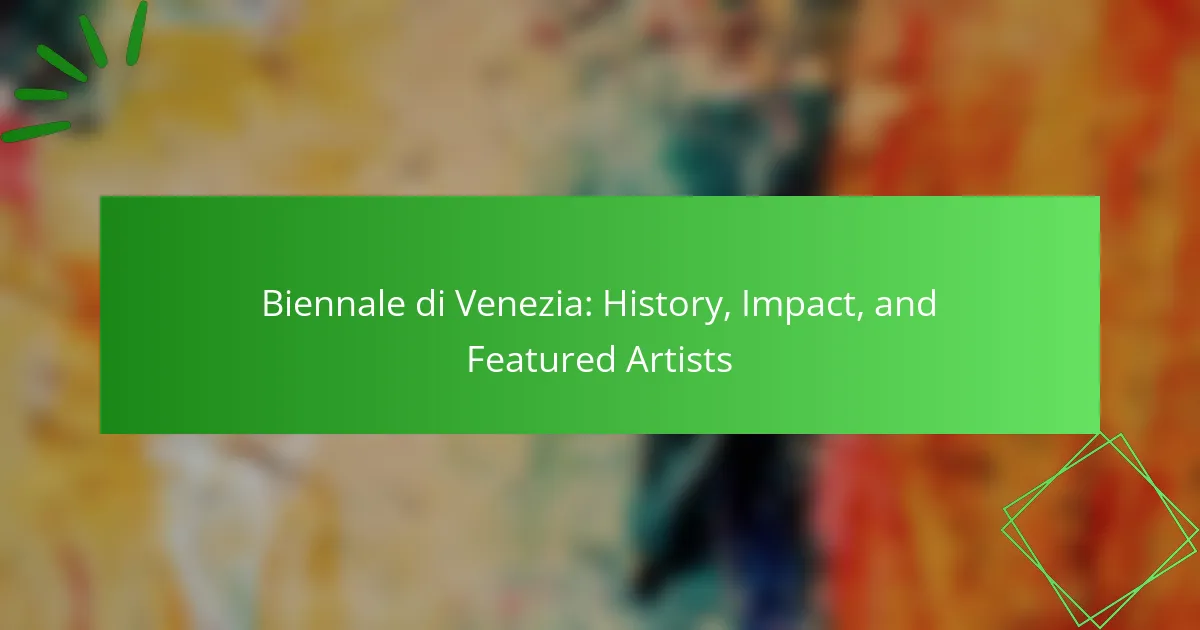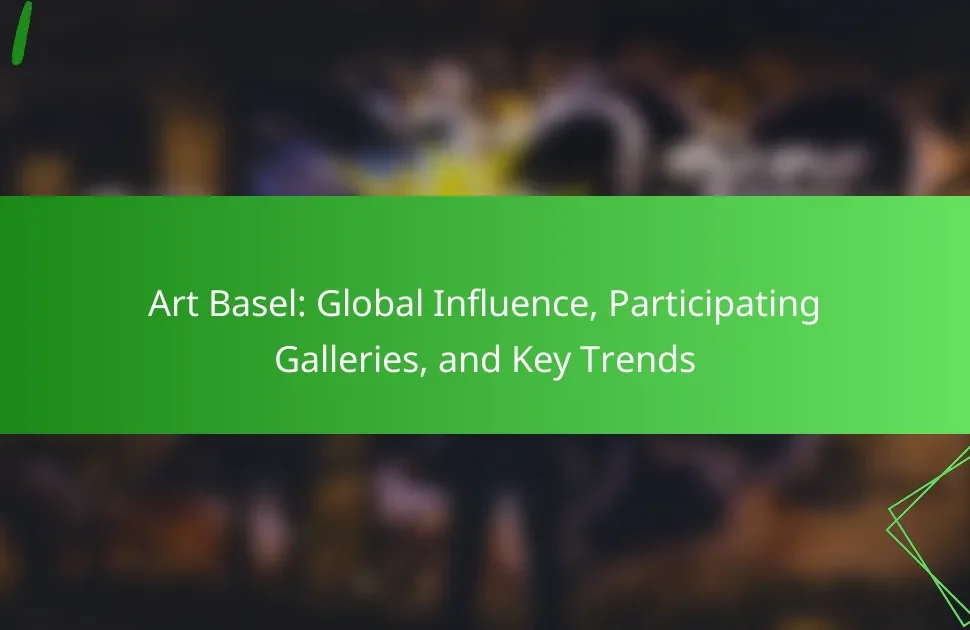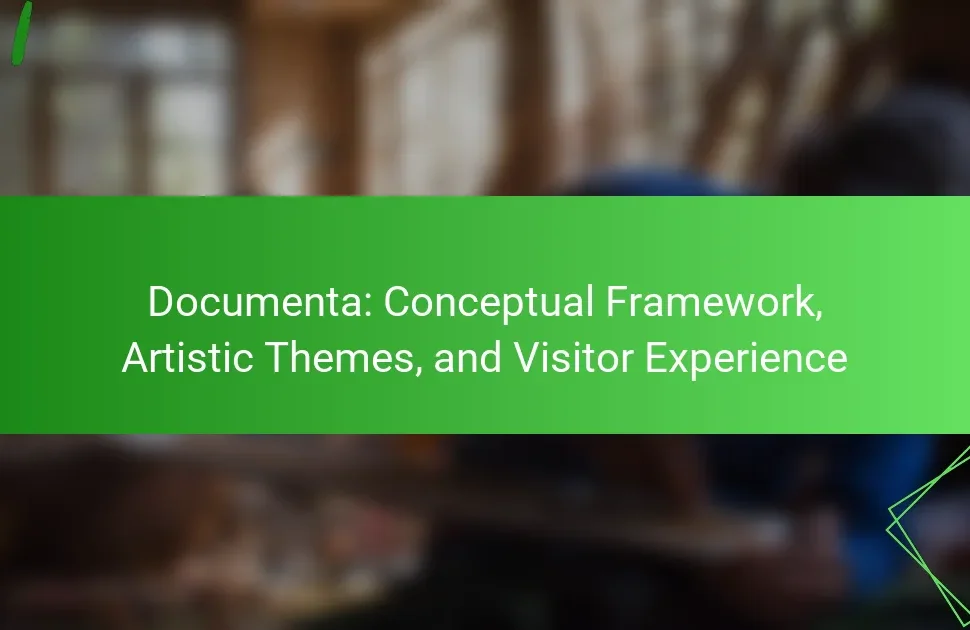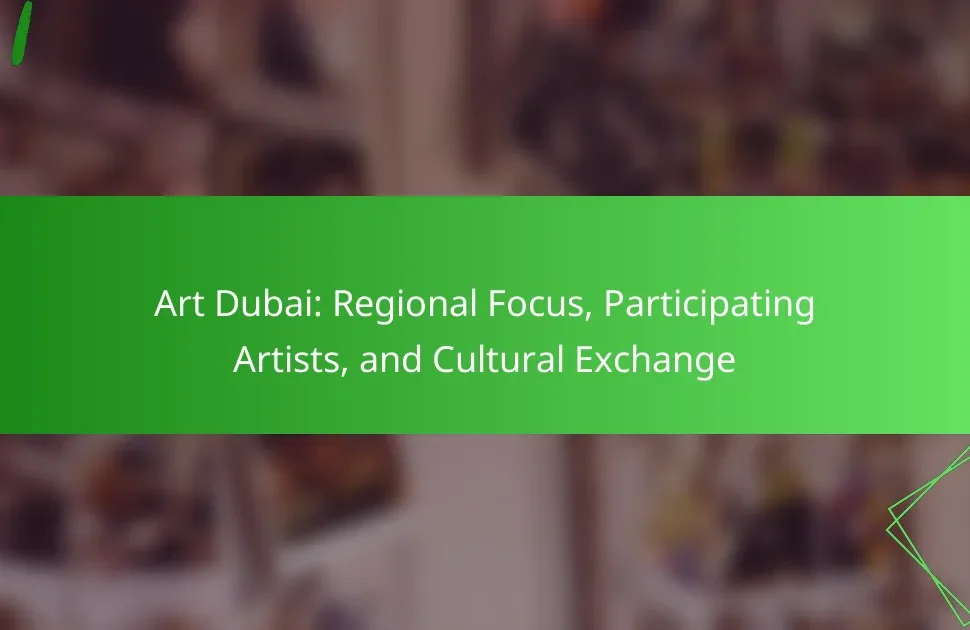The Biennale di Venezia is a premier international art exhibition that has shaped contemporary art since 1895. This article explores its historical significance, impact on global art trends, and highlights featured artists like Yoko Ono and Ai Weiwei. It also examines the event’s role in fostering cultural exchange and its economic influence on Venice. Finally, we will address the challenges the Biennale faces and best practices artists can learn from this prestigious platform.
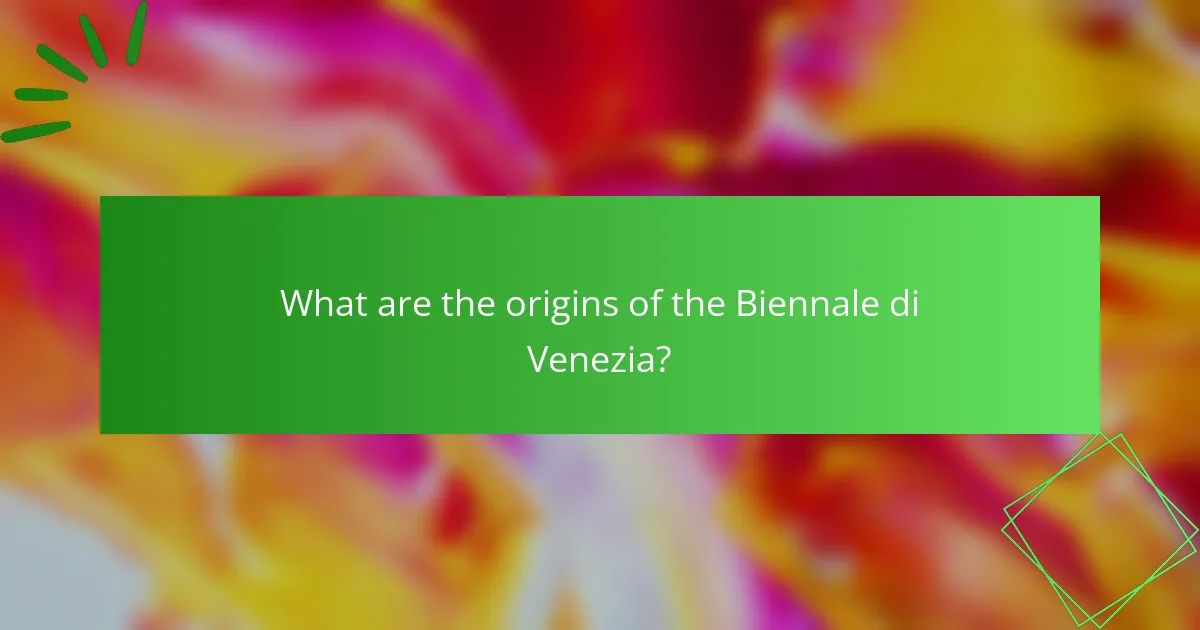
What are the origins of the Biennale di Venezia?
The Biennale di Venezia originated in 1895 as an international art exhibition in Venice, Italy. It aimed to showcase contemporary art and foster cultural exchange. Over the years, it has expanded to include architecture, cinema, dance, music, and theater. The event has significantly influenced global art trends and established Venice as a cultural hub.
How did the event evolve over the decades?
The Biennale di Venezia has evolved significantly since its inception in 1895. Initially focused on visual arts, it has expanded to include architecture, cinema, dance, and music, reflecting broader cultural trends. Over the decades, the event has embraced diverse artistic movements and global participation, showcasing prominent artists like Pablo Picasso and Ai Weiwei. The introduction of national pavilions in 1907 marked a unique attribute, allowing countries to present their cultural identity. Today, the Biennale serves as a platform for contemporary discourse, influencing art worldwide.
Which key milestones shaped its history?
Key milestones in the history of the Biennale di Venezia include its founding in 1895, the introduction of the national pavilions in 1907, and the establishment of the Venice Film Festival in 1932. The event expanded its scope with the introduction of contemporary art exhibitions in the late 20th century, reflecting global artistic trends. Significant moments include the first participation of non-European countries and the awarding of the Golden Lion, which recognizes outstanding contributions. These milestones collectively shaped its role as a pivotal platform for international art dialogue.

How does the Biennale di Venezia influence contemporary art?
The Biennale di Venezia significantly influences contemporary art by showcasing diverse artistic expressions and fostering international dialogue. Established in 1895, it serves as a platform for emerging and established artists, impacting trends and themes in the global art scene. The event promotes cross-cultural exchange, highlighting unique attributes of participating artists and their works. This engagement shapes artistic discourse, inspiring new movements and collaborations within the contemporary art community.
What role does it play in the global art market?
The Biennale di Venezia plays a pivotal role in the global art market by showcasing contemporary art and influencing trends. It connects artists, collectors, and curators, fostering international dialogue and collaboration. The event highlights emerging talents and established names, shaping public perception and market values. Its unique attribute includes the diverse range of national pavilions, reflecting various cultural narratives and artistic practices. As a result, the Biennale serves as a barometer for the art market, impacting sales and exhibitions worldwide.
How do artists and curators perceive its significance?
Artists and curators perceive the Biennale di Venezia as a pivotal platform for contemporary art. It fosters dialogue, showcases diverse perspectives, and highlights emerging trends. The event’s international scope enhances cultural exchange and collaboration. Artists value the exposure and recognition it provides, while curators appreciate its role in shaping the art discourse. The unique setting of Venice adds historical significance, making it a landmark event in the art world.

Who are the featured artists of the 2025 Biennale di Venezia?
The featured artists of the 2025 Biennale di Venezia include a diverse range of global talents. Notable artists are Yoko Ono, Ai Weiwei, and Olafur Eliasson, each known for their unique contributions to contemporary art. This edition emphasizes themes of sustainability and social justice, reflecting current global challenges. The selection showcases both established and emerging artists, fostering a rich dialogue within the art community.
Which emerging artists are gaining attention this year?
Emerging artists gaining attention this year at the Biennale di Venezia include Simone Leigh, who explores themes of identity and culture, and Shirin Neshat, known for her powerful visual narratives. Additionally, artists like Otobong Nkanga and Tishan Hsu are being recognized for their innovative approaches to contemporary issues. Their unique perspectives contribute significantly to the event’s impact on the art world.
What themes are prevalent among this year’s artists?
This year’s artists at the Biennale di Venezia prominently explore themes of identity, climate change, and social justice. Many works reflect on personal narratives and collective experiences, emphasizing cultural heritage. Artists are increasingly using interactive mediums to engage audiences, fostering dialogue about pressing global issues. The integration of technology in art is also a notable trend, enhancing the immersive experience.

What unique attributes distinguish the Biennale di Venezia from other art festivals?
The Biennale di Venezia is distinguished by its long history, international participation, and unique exhibition format. Founded in 1895, it is one of the oldest art festivals, attracting artists from around the globe. Its unique attribute is the national pavilions representing different countries, allowing diverse artistic expressions. Additionally, the Biennale’s impact on contemporary art is profound, influencing trends and fostering dialogue among artists and curators. The festival also features a range of disciplines beyond visual arts, including architecture, dance, and cinema, making it a multidisciplinary platform.
How does its selection process for artists and exhibitions work?
The selection process for artists and exhibitions at the Biennale di Venezia involves a rigorous evaluation by curators and experts. They assess proposals based on artistic merit, innovation, and relevance to contemporary issues. This process ensures a diverse representation of voices and styles, enhancing the event’s global impact. Each edition typically features a mix of established and emerging artists, reflecting the evolving landscape of contemporary art.
What are the standout installations and performances in 2025?
The standout installations and performances in 2025 at the Biennale di Venezia include innovative works from emerging artists and established figures. Notable highlights feature interactive installations that engage audiences, emphasizing themes of sustainability and cultural identity. The event showcases a diverse range of mediums, from digital art to traditional sculpture, reflecting contemporary societal issues. Additionally, performances by acclaimed artists will explore the intersection of art and technology, pushing boundaries in artistic expression.
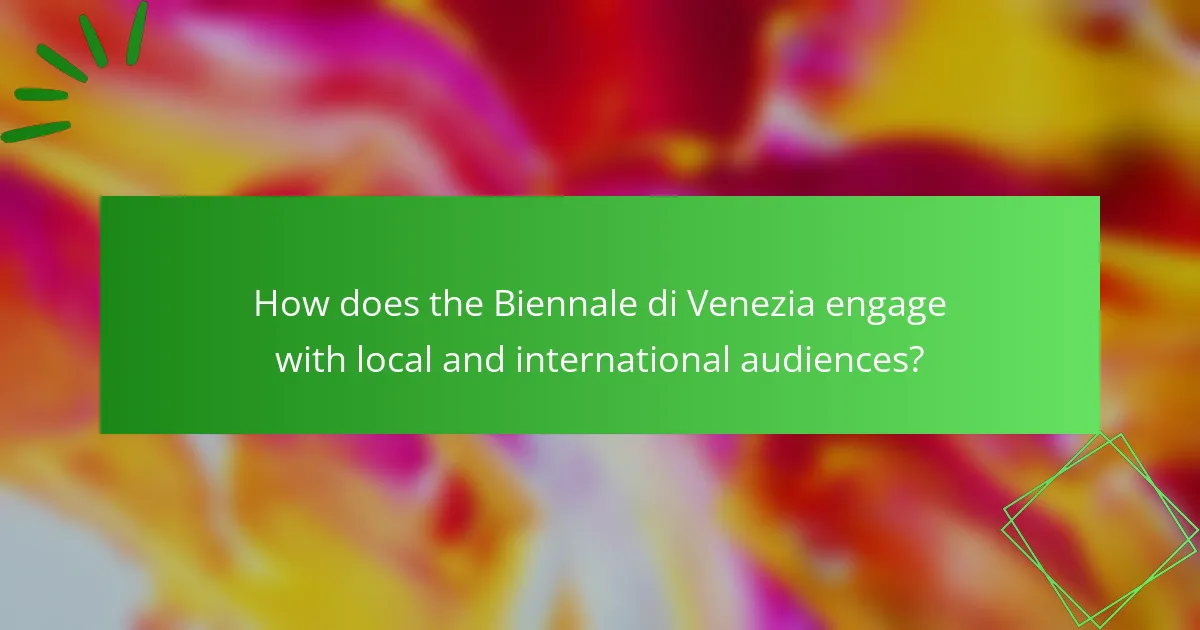
How does the Biennale di Venezia engage with local and international audiences?
The Biennale di Venezia engages local and international audiences through diverse programming and outreach initiatives. It features exhibitions, performances, and educational activities that appeal to various demographics.
The event attracts over 600,000 visitors, showcasing contemporary art and culture. It fosters dialogue between artists and audiences, promoting cultural exchange. Biennale’s international pavilions represent over 80 countries, enhancing global participation.
Additionally, the Biennale hosts workshops and guided tours, making art accessible to local communities. Its digital platforms extend reach, allowing virtual participation and engagement. Thus, the Biennale di Venezia effectively bridges local and international art scenes.
What strategies are used to attract diverse visitors?
The Biennale di Venezia employs various strategies to attract diverse visitors. These include targeted outreach programs, partnerships with international organizations, and inclusive exhibitions that represent a wide range of cultures. Additionally, the event utilizes social media campaigns to engage global audiences and offers educational workshops to encourage participation from different demographics. The biennale’s commitment to diversity enhances its cultural impact and broadens its appeal.
How has audience participation changed over the years?
Audience participation at the Biennale di Venezia has evolved significantly, shifting from elite exclusivity to broader public engagement. Initially, the event catered primarily to art professionals and critics. Over time, it has embraced a more inclusive approach, encouraging diverse audiences to interact with contemporary art.
In recent years, digital platforms have further transformed participation, allowing global audiences to engage virtually. This change reflects a growing recognition of the importance of public involvement in the arts. The Biennale’s outreach programs and community initiatives exemplify this trend, fostering connections between artists and various demographics.
As a result, audience participation now encompasses a wider range of experiences, making the Biennale a more dynamic and accessible cultural event. This shift not only enhances the event’s relevance but also enriches the dialogue around contemporary art.
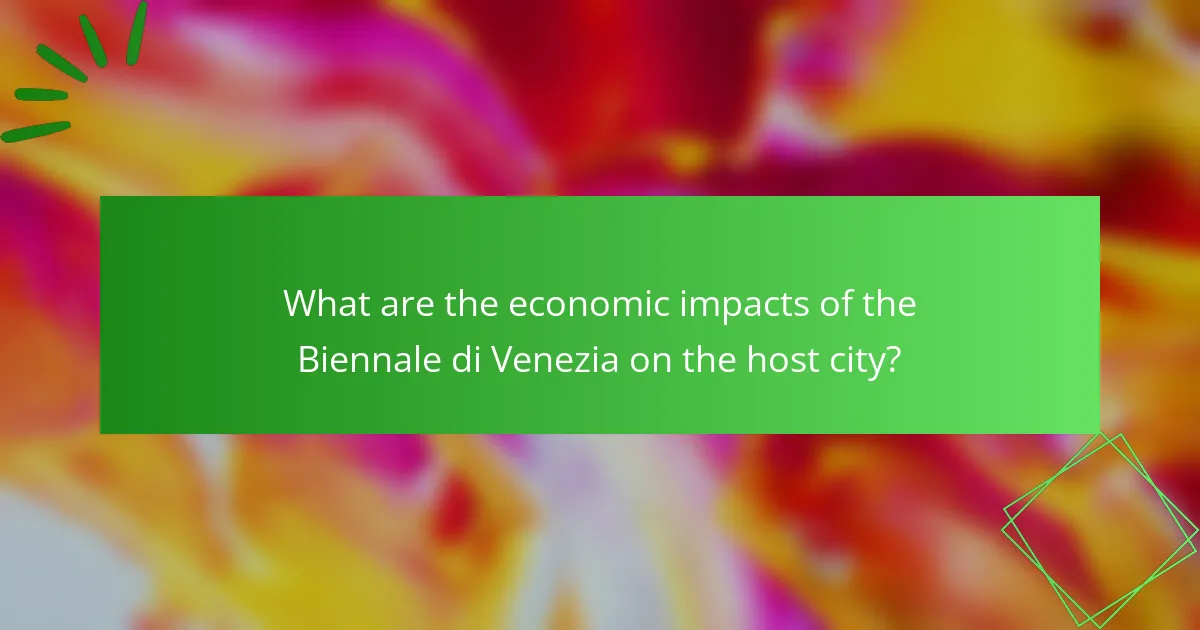
What are the economic impacts of the Biennale di Venezia on the host city?
The Biennale di Venezia significantly boosts the local economy through tourism, cultural investment, and job creation. In 2019, it attracted over 600,000 visitors, enhancing hospitality and retail sectors. Local businesses see increased revenue during the event, with many reporting a 30% rise in sales. The Biennale also fosters long-term cultural investments, enriching the city’s artistic landscape. As a result, Venice’s global cultural status improves, attracting further events and investments.
How does it contribute to tourism and local businesses?
The Biennale di Venezia significantly boosts tourism and supports local businesses. It attracts over 600,000 visitors annually, creating demand for hotels, restaurants, and shops. Local artisans benefit from increased visibility, as many showcase their work during the event. Additionally, the Biennale fosters cultural exchange, enhancing the region’s reputation as a global art destination. This influx of visitors stimulates economic growth, contributing to the sustainability of local enterprises.
What are the long-term benefits for the cultural landscape?
The long-term benefits for the cultural landscape include enhanced global visibility for artists, preservation of artistic heritage, and promotion of cultural exchange. The Biennale di Venezia fosters innovation, encouraging new artistic expressions that reflect evolving societal values. It also stimulates local economies by attracting tourism and investment, ultimately enriching the cultural fabric of the host city.
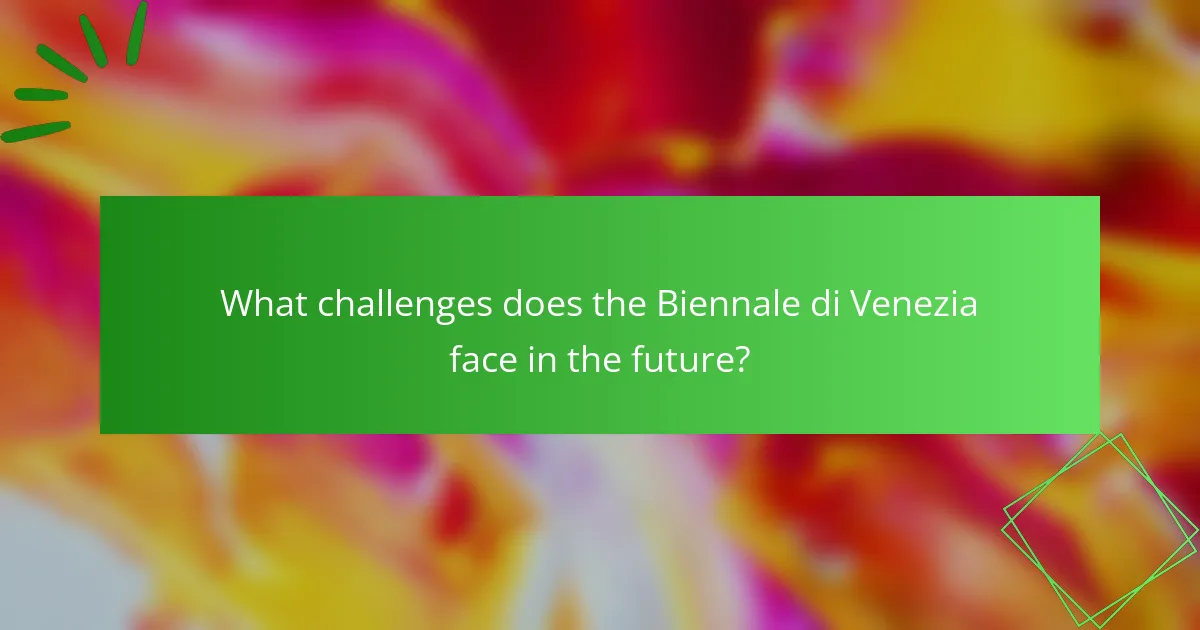
What challenges does the Biennale di Venezia face in the future?
The Biennale di Venezia faces challenges including funding sustainability, evolving audience engagement, and adapting to global art trends. These factors impact its ability to maintain relevance and attract diverse artists. Additionally, addressing climate change and cultural representation will be crucial for its future success.
How is it adapting to changes in the art world?
The Biennale di Venezia adapts to changes in the art world by embracing contemporary themes and diverse artistic expressions. It showcases emerging artists alongside established figures, reflecting current societal issues. The event has integrated digital art and interactive installations, responding to technological advancements. Additionally, it fosters global dialogue, encouraging participation from underrepresented regions and cultures, thus enriching the art landscape.
What environmental considerations are being addressed?
The Biennale di Venezia addresses environmental considerations through sustainable practices and eco-friendly initiatives. Exhibitions often highlight climate change and biodiversity, encouraging awareness and action. Artists are increasingly using recycled materials and exploring themes of environmental impact, reinforcing the event’s commitment to ecological responsibility. This approach not only promotes artistic expression but also engages the public in critical conversations about sustainability.
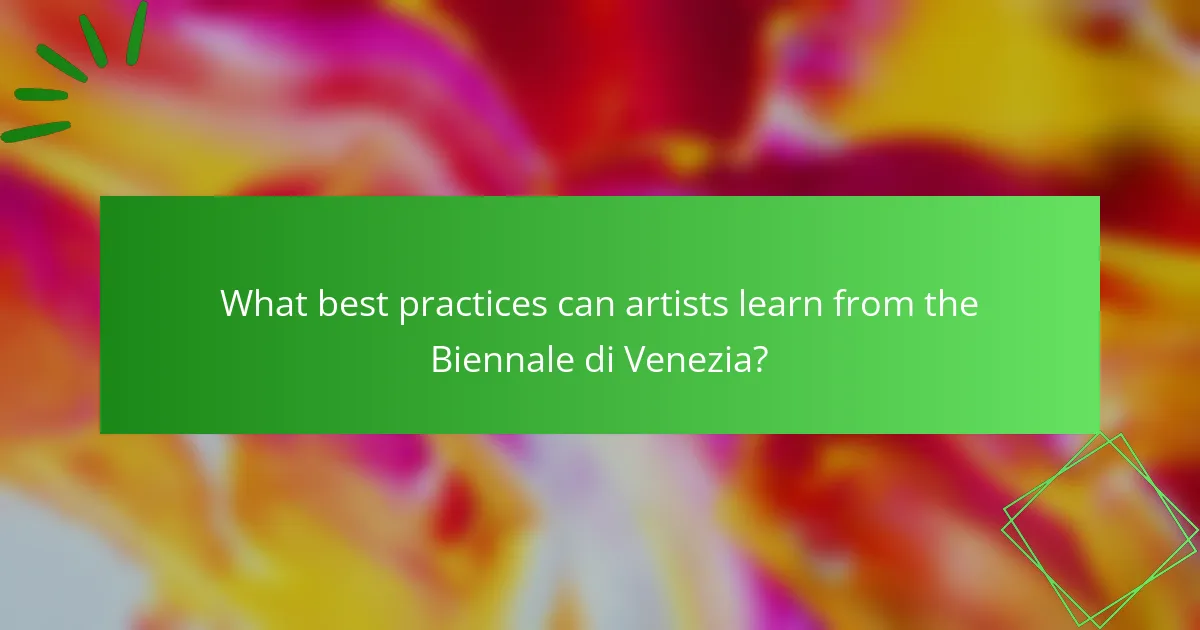
What best practices can artists learn from the Biennale di Venezia?
Artists can learn several best practices from the Biennale di Venezia, focusing on innovation, collaboration, and audience engagement. The event emphasizes the importance of pushing creative boundaries, encouraging artists to explore new mediums and concepts. Networking with international artists fosters collaboration, enriching artistic perspectives. Additionally, the Biennale’s diverse audience highlights the need for effective communication and engagement strategies to connect with viewers. Embracing these practices can enhance an artist’s visibility and impact in the contemporary art world.
How can emerging artists leverage exposure from the event?
Emerging artists can leverage exposure from the Biennale di Venezia by showcasing their work to a global audience, networking with industry professionals, and gaining recognition through participation. This prestigious event attracts art collectors, curators, and media, providing invaluable opportunities for collaboration and future exhibitions. By engaging with diverse audiences, artists can enhance their visibility and establish their unique artistic identity.
What common mistakes should artists avoid when participating?
Artists should avoid common mistakes such as inadequate preparation, neglecting networking, and failing to understand the audience.
1. Inadequate preparation can lead to poor presentation.
2. Neglecting networking reduces opportunities for collaboration.
3. Failing to understand the audience may result in misaligned themes.
4. Ignoring promotional strategies limits visibility and engagement.
5. Overlooking logistics can cause unnecessary complications.
